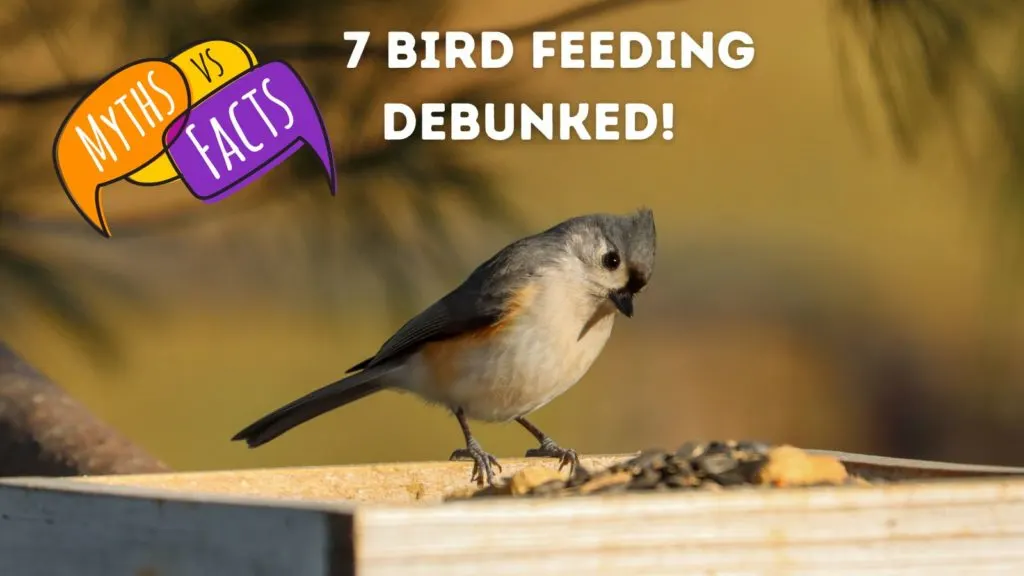Feeding birds in your backyard is a popular hobby that connects people with nature and provides essential support to local bird populations. However, several myths surrounding bird feeding can lead to confusion and potentially harmful practices. Let’s debunk some of the most common bird feeding myths and set the record straight!

Myth 1: Birds Become Dependent on Feeders
Debunked: Birds are opportunistic feeders that utilize a wide range of food sources. While feeders do provide an easy meal, studies show that birds typically get only about 25% of their daily food from feeders. They naturally forage for the rest, ensuring they do not become dependent on human-provided food.
Feeding stations can be particularly beneficial during certain times, such as harsh winters or during the breeding season when additional nutrition can be crucial. However, birds have adapted to find food from a variety of sources, and their survival is not solely dependent on the availability of feeders.
Similarly hummingbirds, like other bird species, do not become entirely dependent on feeders. They are naturally adept at finding a wide range of food sources, including nectar from flowers, small insects, and tree sap, which provide them with the necessary nutrients for their high-energy lifestyle. Feeders offer a supplementary source of nectar, especially beneficial during times when natural food sources may be less abundant, such as early spring or late fall, or in urban areas where floral resources are limited.
Myth 2: Feeding Birds in Summer is Bad
Debunked: There’s a belief that feeding birds during the summer months can be harmful or unnecessary. However, feeding birds year-round has benefits!
Summer is a time of abundance for most birds, with plenty of natural food sources available, but supplemental feeders can still support local bird populations in several ways:
- Support for Parent Birds: During the breeding season, parent birds are busy raising their young. Feeders can offer a readily accessible food source for adult birds, which in turn can help them spend less time foraging and more time tending to their nestlings.
- Nutritional Supplement: While natural food sources are abundant in summer, feeders can supplement birds’ diets with additional nutrients that might be less plentiful, especially during periods of dry weather when insects and natural fruits may be harder to find.
- Drought Conditions: In times of drought, natural water and food sources can become scarce. Bird baths and feeders can become vital resources for birds during these periods.
- Attracting a Variety of Species: Feeding birds in the summer can attract a wider variety of species to your yard, including some that may not typically visit feeders during other times of the year due to migratory patterns or changing food preferences.
Myth 3: Bread is a Good Food for Birds
Debunked: Bread, especially white bread, offers little nutritional value to birds and can lead to health problems if consumed in large quantities.
It’s best to avoid feeding birds bread and instead provide seeds, nuts, and fruits that cater to their nutritional needs.
Myth 4: If You Start Feeding Birds, You Must Never Stop
Debunked: While consistent feeding is helpful, especially during winter, birds are adaptable and will seek other food sources if your feeders are empty.
It’s beneficial to feed regularly, but there’s no need to worry if you go on vacation or miss a few days!
Myth 5: Feeders Cause Birds to Hit Windows More Frequently
Debunked: Bird strikes can happen, but feeder placement is key.
Position feeders either closer than 3 feet or further than 30 feet from windows to reduce collision risk. This helps birds not to gain enough speed for a dangerous impact if they’re close and gives them enough room to maneuver if feeders are far.
Myth 6: Only a Few Bird Species Use Feeders
Debunked: A variety of bird species enjoy feeders, depending on the food offered and the feeder type.
By varying the food (e.g., seeds for finches, suet for woodpeckers) and feeder styles (tube feeders, platform feeders), you can attract a diverse array of birds to your yard.
And if you add a water feature–whether that’s a bird bath or a fountain–you’ll also attract birds that don’t come to feeders. (At our house, the endangered Golden-cheeked Warblers don’t come to feeders–but they sure love the dripping water!)
Myth 7: Feeding Birds Leads to Overpopulation
Debunked: Bird populations regulate themselves based on available resources and environmental conditions. Feeding does not cause overpopulation but can support bird communities when natural food sources are scarce, such as during urban development or harsh winters.
Understanding the truths behind these myths can enhance your bird feeding experience and ensure you’re providing the best support to your feathered friends. Happy bird feeding!
More Posts You Might Like
What Color Bird Feeder Attracts the Most Birds?
How to Prevent Mold in Hummingbird Feeder
- 8 Letter Bird Names - August 14, 2024
- 7 Letter Bird Names - August 14, 2024
- 7 Birds Named After Famous People - July 23, 2024
